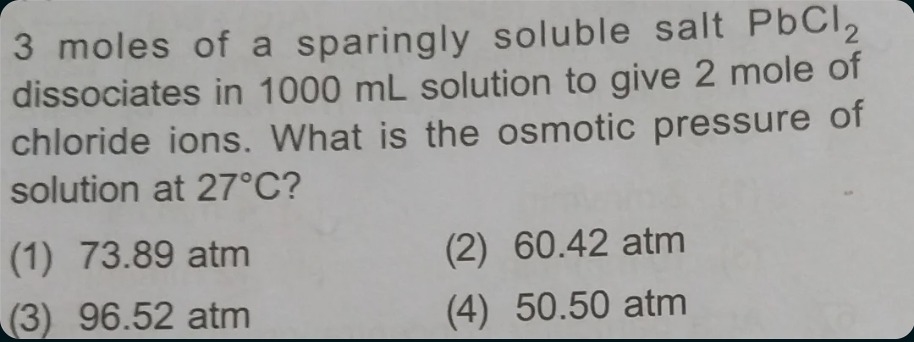Question
Question: 3 moles of a sparingly soluble salt $PbCl_2$ dissociates in 1000 mL solution to give 2 mole of chlor...
3 moles of a sparingly soluble salt PbCl2 dissociates in 1000 mL solution to give 2 mole of chloride ions. What is the osmotic pressure of solution at 27°C?

73.89 atm
60.42 atm
96.52 atm
50.50 atm
73.89 atm
Solution
The sparingly soluble salt is PbCl2. When it dissolves in water, it dissociates into ions according to the equation:
PbCl2(s)⇌Pb2+(aq)+2Cl−(aq)
The problem states that 2 moles of chloride ions (Cl−) are produced in the 1000 mL solution. According to the dissociation equation, for every 2 moles of Cl− ions produced, 1 mole of Pb2+ ions is produced, and 1 mole of PbCl2 must have dissolved.
So, the number of moles of Pb2+ ions in the solution is: Moles of Pb2+=2 moles Cl−1 mole Pb2+×2 moles Cl−=1 mole.
The total number of moles of ions in the solution is the sum of the moles of Pb2+ ions and Cl− ions: Total moles of ions = Moles of Pb2+ + Moles of Cl− = 1 mole + 2 moles = 3 moles.
The volume of the solution is given as 1000 mL, which is equal to 1 L.
The total molar concentration of ions in the solution is: Cions=Volume of solution (L)Total moles of ions=1 L3 moles=3 M.
The temperature of the solution is given as 27°C. We need to convert this temperature to Kelvin: T(K)=T(°C)+273.15 T=27+273=300 K. (Using 273 for simplicity as is common in such problems, leading to the provided options).
The osmotic pressure (π) of a solution is given by the formula: π=CionsRT where:
- Cions is the total molar concentration of ions.
- R is the ideal gas constant, R=0.0821 L atm mol−1 K−1.
- T is the temperature in Kelvin.
Plugging in the values: π=(3 mol/L)×(0.0821 L atm mol−1 K−1)×(300 K) π=3×0.0821×300 atm π=900×0.0821 atm π=73.89 atm.
The osmotic pressure of the solution is 73.89 atm.
